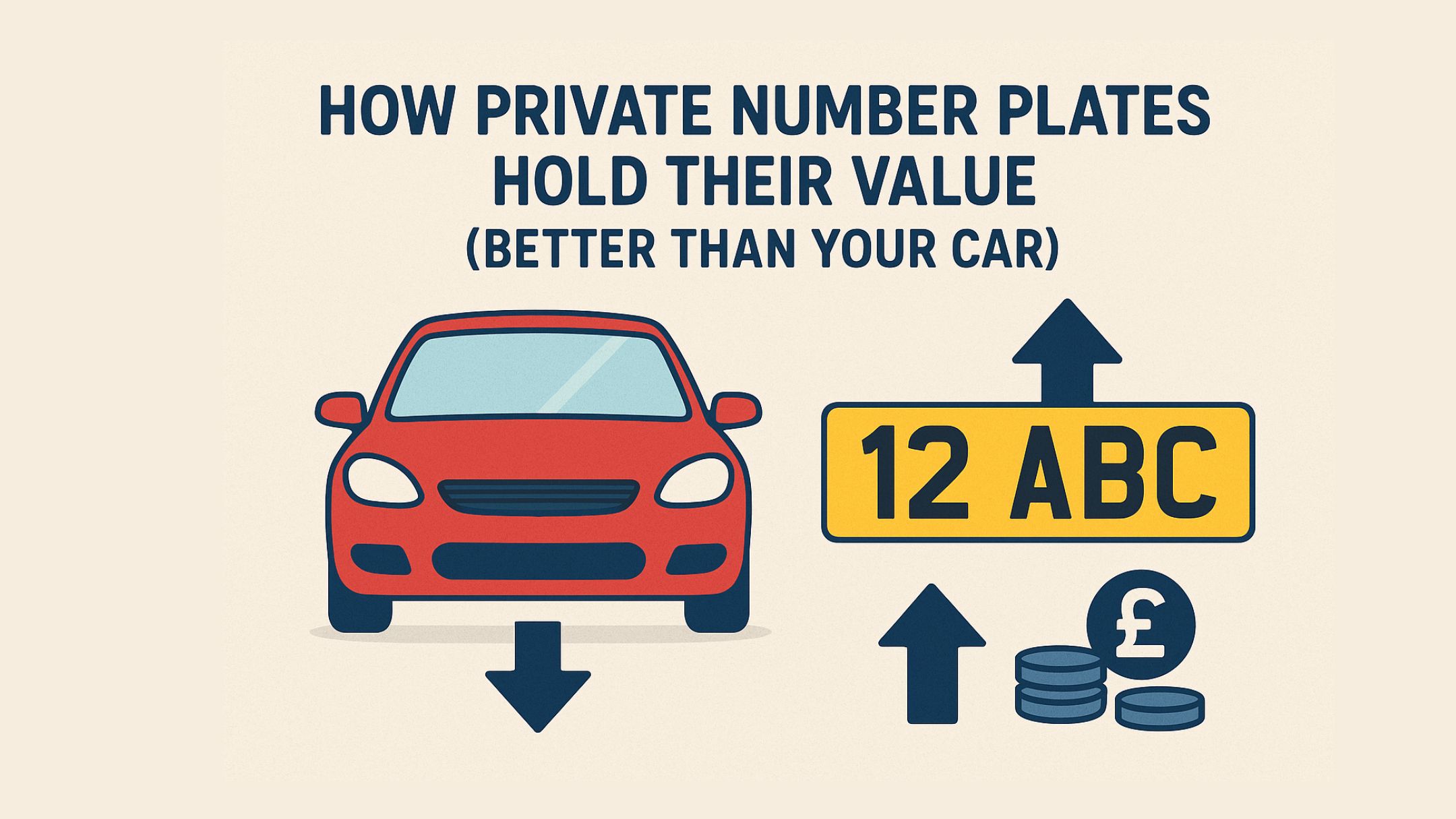Most people accept car depreciation as an inevitable fact of life. Drive a new vehicle off the forecourt and it loses thousands in value before you’ve even made it home. But here’s something that doesn’t follow the same depressing trajectory: the number plate attached to it.
While that shiny new motor steadily loses value year after year, a well-chosen private registration can hold steady or even appreciate. It’s one of the few car-related purchases where you’re not automatically throwing money away. And yet, most drivers never think about plates as anything more than the legal requirement bolted to the bumper.
The reality is more interesting than that.
The Depreciation Game Nobody Wins
A new car typically loses about 40% of its value within the first year. By year three, it’s down to roughly 60% of what was paid for it. By year five, half the original price has evaporated. This isn’t news to anyone who’s ever tried to sell a used vehicle.
What catches people off guard is just how relentless this process is. Doesn’t matter if the car’s been garaged, barely driven, or maintained like a museum piece—the clock keeps ticking and the value keeps dropping.
Meanwhile, that registration plate? It doesn’t age. A plate doesn’t rack up miles, develop mechanical issues, or go out of fashion because a newer model exists. The letters and numbers that spell out a name or a word don’t become obsolete when the next registration format comes along.
Why Plates Don’t Follow the Same Rules
The key difference comes down to scarcity and demand. Cars are manufactured by the thousands. Even limited editions aren’t usually that limited. But each private registration is genuinely one-of-a-kind. Once someone owns B055 or JAM 3S, nobody else can have it.
This creates a completely different market. When something can’t be replicated, its value isn’t tied to production costs or manufacturing trends. It’s tied to how much someone else wants it.
For anyone considering personalization options, exploring Private Plates reveals how accessible this market has become, with registrations available at various price points that tend to maintain their worth far better than the vehicles they’re attached to.
The Plates That Actually Gain Value
Not every private registration appreciates, but certain types have shown consistent growth over time. Short combinations—especially single letters or numbers—tend to increase in value because there’s a limited supply and high demand. A plate reading just F 1 or G 1 is always going to be desirable.
Names work differently. Common first names hold steady because there’s always someone with that name in the market for a plate. James, Sarah, David—these don’t go out of fashion. But unusually spelled names or very rare names can be harder to shift.
Then there’s the word plates. Anything that spells out something recognizable—BOSS, KING, CHEF—these maintain value well because they appeal to anyone in that profession or with that interest, not just people with a specific name.
The real winners tend to be plates that could work for multiple purposes. A plate that spells a name but could also be read as a word has two potential buyer pools instead of one.
What Actually Affects a Plate’s Worth
Age matters, but not in the way it does with cars. Older registrations (the dateless ones with no year identifier) are generally more valuable because they’re rarer and they don’t date your vehicle. Nobody can look at your car and immediately know it’s from 2003 if you’re running a dateless plate.
The format plays a big role, too. Dateless plates sit at the top, followed by prefix (letter then numbers), then suffix (numbers then letter), and finally the current format that’s been running since 2001. Each time the DVLA introduces a new format, the previous ones become more limited in supply.
Readability is huge. A plate that requires mental gymnastics to decipher isn’t worth much. The easier it is to see what it says at a glance, the more people will want it. Using a 3 for an E or a 5 for an S is fine because everyone recognizes those substitutions. Getting more creative than that usually backfires.
The Transfer Factor
Here’s where private plates really differ from cars: they’re portable. When you’re done with a vehicle, you can take the registration off and move it to your next one. Or you can hold onto it without assigning it to anything at all.
This flexibility means a plate never becomes obsolete because the car it’s on gets old. The registration exists independently. It’s not tied to a specific vehicle’s lifespan or condition.
Compare that to fitting expensive alloy wheels or a premium sound system. Those modifications might improve your driving experience, but they’re stuck to the car. When you sell, you either lose them or try to remove them (which causes its own headaches). And they rarely add enough resale value to justify what was spent on them.
The Real-World Numbers
Looking at actual sales data tells the story. A basic private registration might cost £250 to £500. That same plate five years later? Still £250 to £500, maybe more if it’s particularly good. Has the car been on during those five years? Down by thousands.
Premium plates follow the same pattern but at higher stakes. A registration that cost £5,000 ten years ago isn’t worth £2,500 now. It’s likely still around £5,000, possibly more depending on market trends.
There’s no guarantee—nothing appreciates in a straight line—but the track record is pretty clear. Plates don’t depreciate the way physical assets do.
When It Doesn’t Work
Private registrations aren’t a foolproof investment. Buying a plate purely for profit is risky because you’re betting on future demand for something very specific. If nobody wants your particular combination when you’re ready to sell, the plate isn’t worth anything beyond its base registration value.
Overpaying is easy, too. The market for private plates is emotional. People get attached to combinations that spell their name or mean something personal, and they’ll pay more than the plate’s actual market value. That’s fine if you’re buying it to keep, but if you’re thinking about resale value, overpaying creates an immediate loss.
Trendy phrases or references can also backfire. What seems clever now might feel dated in ten years. Plates tied to specific cultural moments don’t age well.
The Practical Side
Unlike cars, storing a private registration costs almost nothing. Once you’ve purchased it, there’s a small retention fee every few years if you’re not keeping it on a vehicle, but that’s minimal compared to the cost of storing an actual car.
Selling is straightforward, too. The DVLA handles the transfer paperwork, so it’s not the same hassle as selling a vehicle privately. There’s no MOT to worry about, no service history to maintain, no arguments about minor damage or discrepancies in the advert.
The Bottom Line
A car is a depreciating asset dressed up as a purchase. Everyone knows this, but we buy them anyway because we need transportation. Private registrations occupy a different category entirely—they’re discretionary, but they don’t follow the same downward trajectory.
Will a private plate make anyone rich? Probably not, unless they happened to buy something incredibly desirable years ago for peanuts. But will it hemorrhage value the way the car itself does? No. And for something visible every time the vehicle’s on the road, that’s worth considering.
The gap between what’s paid for a decent private registration and what it’s worth five or ten years later is negligible. The gap between what’s paid for a car and what it’s worth over that same period is eye-watering.
It’s not about getting rich. It’s about being one of the few car-related expenses that doesn’t automatically lose money.




